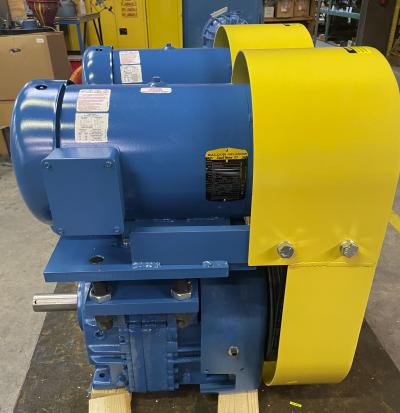
Posidyne® clutch brakes can be ordered with special pads cast into the main housings to mount an adjustable motor base, allowing the motor to sit atop the clutch brake in a space saving “piggyback” design. Ideal for precise positioning applications with tight space constraints where an inline arrangement is not feasible, this arrangement also includes a gear belt drive from the motor to the input shaft and an enclosed belt drive guard.
Designed for tight quarters, the Posidyne® features oil shear technology that allows rapid and precise stopping, starting, speed change and positioning, all without adjustment or maintenance. Posidyne® piggyback clutch brakes are well suited for applications with frequent start/stop cycles, and high cycle rates (up to 300 cycles per minute), which place a high priority on maximizing production and minimizing downtime.
Faster production rates coupled with significantly longer service life than traditional (dry) clutch/brakes (5 to 10 times longer in many cases) yields increased uptime, productivity and ROI. No adjustment, virtually no maintenance, multi-year service life, minimal parts inventory, reduced parts and replacement ordering cost, adds up to higher production at less cost.
Designed with low inertia cycling components makes the Posidyne® clutch brake more efficient, requiring less motor horsepower to accelerate the load, and less torque to stop the load. Their totally enclosed design is impervious to dust, chips, chemicals, coolants, caustic wash down, weather, and more, making them ideal for hostile environments. They are field proven in diverse applications such as lumber mills, shingle plants, fiberglass insulation production, food processing, packaging, metalworking, and more.
Posidyne® clutch/brakes feature a multiple disc design that produces high torque from a small package. Re-circulating the fluid dissipates the heat of engagement, which is a common cause of downtime with other clutch/brake assemblies.
A simple actuation system allows torque in the clutch and brake to be precisely controlled. Adjustment for rapid or soft starts and stops is easily accomplished. Manifold mounted control valves reduce response times by eliminating hoses and fittings and are recommended for high cycle applications. By reducing the high starting inrush currents and the associated power factor imbalance in the motor these unique clutch/brakes can also reduce energy costs.
The Posidyne® clutch brake can be actuated by air or hydraulic pressure for use in a plant or outside remote applications. The hydraulic actuation package includes a hydraulic pump, solenoid valve, regulators, and a filter. A heat exchanger can be added for additional cooling.
The Posidyne® is inherently explosion proof with the addition of an explosion proof actuation valve or locating the valve in an explosion proof cabinet. Multiple sizes are available to suit applications from ½ to 350 HP (99 Lb. In. to 79,000 Lb. In.) with cooling options, control logic and mounting arrangements to simplify and speed installation.
Oil Shear Technology Makes the Difference
Oil Shear Technology is the reason that brakes by Force Control last up to 10 times longer than standard dry friction brakes and do not need maintenance, adjustment, or disc replacement. Oil Shear Technology is the function of a boundary layer of transmission fluid in shear between the friction discs and drive plates. As the parts come together, the fluid in shear will transmit torque between the two parts, as well as absorb heat. This eliminates direct contact of the friction discs and drive plates during high-speed slip. Heat from the friction surface is dissipated as the fluid circulates to the housing.
Heat dissipation is a major component when selecting a clutch brake. The Posidyne® clutch brake basic unit dissipates heat through a unique internal design pumping system which causes the transmission fluid to be drawn into the center of the hub, flows through the friction stack, and by centrifugal force is pulled out of the stack to the housing. Cooling occurs as the fluid flows down the housing walls. Additional heat can be dissipated by adding water-cooling, or pulling the fluid out of the unit for additional heat exchanger cooling and filtration. These cooling options allow the same compact size Posidyne® clutch brake to be used on high inertia loads, or in extremely high or low temperatures.
Contact Details
Related Glossary Terms
- metalworking
metalworking
Any manufacturing process in which metal is processed or machined such that the workpiece is given a new shape. Broadly defined, the term includes processes such as design and layout, heat-treating, material handling and inspection.






